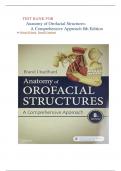TEST BANK FOR Anatomy of Orofacial Structures: A Comprehensive Approach 8th Edition by Richard W Brand , Donald E Issel hard Table of Contents Chapter 01: Oral Cavity ................................ ................................ ................................ ................................ .............. 3 Chapter 02: The Tooth: Functi ons and Terms ................................ ................................ ................................ ......... 16 Chapter 03: Fundamental and Preventive Curvatures ................................ ................................ .............................. 29 Chapter 04: Dentition ................................ ................................ ................................ ................................ ............... 38 Chapter 05: Development, Form, and Eruption ................................ ................................ ................................ ....... 47 Chapter 06: Occlusion ................................ ................................ ................................ ................................ .............. 56 Chapter 07: Dental Anomalies ................................ ................................ ................................ ................................ . 67 Chapter 08: Supporting Structures ................................ ................................ ................................ ........................... 75 Chapter 09: Clinical Considerations ................................ ................................ ................................ ......................... 86 Chapter 10: Tooth Identification ................................ ................................ ................................ .............................. 96 Chapter 11: Root Morphology ................................ ................................ ................................ ................................ 106 Chapter 12: Incisors ................................ ................................ ................................ ................................ ................ 117 Chapter 13: Canines ................................ ................................ ................................ ................................ ............... 126 Chapter 14: Premolars ................................ ................................ ................................ ................................ ............ 136 Chapter 15: Molars ................................ ................................ ................................ ................................ ................. 148 Chapter 16: Deciduous Dentition ................................ ................................ ................................ ........................... 162 Chapter 17: Basic Tissues ................................ ................................ ................................ ................................ ...... 172 Chapter 18: Development of Orofacial Complex ................................ ................................ ................................ ... 183 Chapter 19: Dental Lamina and Enamel Organ ................................ ................................ ................................ ..... 194 Chapter 20: Enamel, Dentin, and Pulp ................................ ................................ ................................ ................... 204 Chapter 21: Root Formation and Attachment Apparatus ................................ ................................ ....................... 215 Chapter 22: Eruption and Shedding of Teeth ................................ ................................ ................................ ......... 227 Chapter 23: Oral Mucous Membrane ................................ ................................ ................................ ..................... 237 Chapter 24: The Tongue ................................ ................................ ................................ ................................ ......... 247 Chapter 25: Histology of the Salivary Glands ................................ ................................ ................................ ........ 257 Chapter 26: Osteology of the Skull ................................ ................................ ................................ ........................ 266 Chapter 27: Nose, Nasal Cavity, and Paranasal Sinuses ................................ ................................ ........................ 277 Chapter 28: Muscles of Mastication, Hyoid Muscles, and Sternocleidomastoid and Trapezius Muscles ............... 287 Chapter 29: Temporomandibular Joint ................................ ................................ ................................ ................... 297 Chapter 30: Muscles of Facial Expression ................................ ................................ ................................ ............. 306 Chapter 31: Soft Palate and Pharynx ................................ ................................ ................................ ...................... 315 Chapter 32: Arterial Supply and Venous Drainage ................................ ................................ ................................ 325 Chapter 33: Salivary Glands ................................ ................................ ................................ ................................ ... 334 Chapter 34: Nervous System ................................ ................................ ................................ ................................ .. 343 Chapter 35: Lymphatics and Spread of Dental Infection ................................ ................................ ....................... 354 Chapter 36: Anatomical Considerations of Local Anesthesia ................................ ................................ ................ 363 Chapter 01: Oral Cavity Brand/Isselhard: Anatomy of Orofacial Structures, 8th Edition MULTIPLE CHOICE 1. A diastema is a space between two teeth in the same arch. When this occurs between the maxillary central incis ors, it is often the result of a pronounced labial frenum. a. Both statements are true. b. The first statement is true; the second statement is false. c. The first statement is false; the second statement is true. d. Both statements are false. ANS: A A space, or lack of contact area, between any two teeth in the same arch is called a diastema. When a diastema occurs between the maxillary central incisors, it is often the result of a pronounced labial frenum extending to the crest of the alveolar ridge and possibly over the ridge. This band of firm connective tissue causes the erupting incisors t o be pushed aside resulting in a diastema, or space. Correction of a diastema usually involves surgical removal, or cutting, of the frenal tissue between teeth. REF: p. 3 OBJ: To describe the boundaries and sub-boundaries of the oral cavity and the structures in each area NAT: CDA: GC I.A.6. Identify basic oral anatomy and physiology, including but not limited to: oral cavity. TOP: BLOOM: Remembering 2. Torus palatinus is seen on the a. soft palate b. hard palate c. alveolar ridge d. oral pharynx ANS: B Torus palatinus is excess bone growth and occurs in the midline of the hard palate. It may grow to varying sizes and is generally only a problem when the construction of a maxillary denture is necessary. In health, such bony protuberances, or excess bone g rowths, do not occur on the soft palate, alveolar ridge, or oral pharynx. REF: p. 5 OBJ: To define the terms vestibule, oral cavity proper, mucobuccal fold, frenum, alveolar mucosa, gingiva, exostoses, torus palatinus, and torus mandibularis NAT: CDA: GC I.A.2. Identify basic oral anatomy and physiology, including but not limited to: bones. TOP: BLOOM: Remembering 3. Contraction of which muscle raises the tongue upward? a. Mylohyoid b. Palatopharyngeal c. Palatoglossal d. Levator glossal ANS: A U S N T Contraction of the mylohyoid muscle raises the tongue. The palatopharyngeal muscle and the palatoglossal muscle form the posterolateral borders of the oral cavity. There is not a muscle by the name of levator glossal. REF: p. 7 OBJ: To define the landmarks in the floor of the mouth and the hard and soft palate and the structures that form them NAT: CDA: GC I.A.4. Identify basic oral anatomy and physiology, including but not limited to: muscles. TOP: BLOOM: Remembering 4. The oral vestibule is partially bordered by the lips and cheeks. The oral cavity proper extends posteriorly to the soft palate. a. Both statements are true. b. The first statement is true; the second statement is false. c. The first statement is false; the second statement is true. d. Both statements are false. ANS: B The oral vestibule is the space or potential space that exists between the lips or cheeks and teeth. In an edentulous person, the vestibule would extend between the lips or cheeks and the alveolar ridge s. The oral cavity proper is surrounded by teeth or alveolar ridges and extends all the way back to the palatine tonsils. This includes the region from the floor of the mouth upward to the hard and soft palates. REF: p. 2 OBJ: To describe the boundaries and sub-boundaries of the oral cavity and the structures in each area NAT: CDA: GC I.A.6. IdentifyNbasRic oIral aGnatoBm.yCandMphysiology, including but not limited to: oral cavity. TOP: BLOOM: Remembering 5. Each of the following is true of the uvula EXCE PT one. Which one is the EXCEPTION? a. It is located at the most posterior portion of the hard palate. b. It is located at the midline. c. It is a downwardly projecting muscle. d. It is necessary for swallowing. ANS: D The uvula is a downwardly projecting muscular tissue located at the midline of the most posterior portion of the hard palate. It is NOT necessary for swallowing. REF: p. 6 OBJ: To define the landmarks in the floor of the mouth and the hard and soft palate and the structures that form them NAT: CDA: GC I .A.6. Identify basic oral anatomy and physiology, including but not limited to: oral cavity. TOP: BLOOM: Remembering 6. The circumvallate papillae are located on the hard palate, buccal mucosa, and floor of the mouth. The papillae found on the tongue are the filiform, fungiform, vallate, foliate, and incisive. a. Both statements are true. b. The first statement is true; the second statement is false. c. The first statement is false; the second statement is true.





